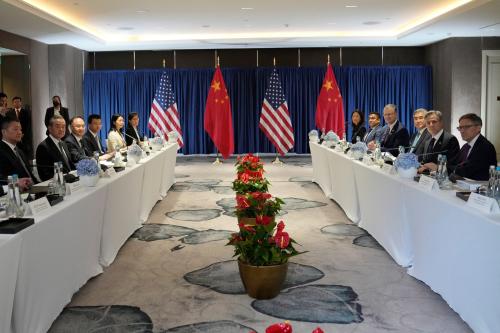In assessing swings in the balance of power, economic reductionism is tempting but very misleading. To be sure, countries with a large gross domestic product (GDP) sometimes convert some of those economic resources into military power, and sometimes they actually use that military power in ways that upset the existing order. But there is no inevitability here. To take a current example, just because China will soon have the largest GDP in the world does not necessarily mean that it will seek to overturn the East Asian status quo. What will be important are the choices that Chinese leaders make about how to use their country’s growing economic clout. (Note: these estimates are on a purchasing power parity basis, which many economists believe makes an economy bigger than it actually is. But that’s a topic for a future commentary.)
A historical example illuminates my point that choices are more important than gross rankings. The example is World War I, which created long-lasting chaos from relative order. According to the conventional narrative, August 1914 was the result of Germany’s challenge of Great Britain’s dominant position in the international system. Yet this narrative is at odds with the economic rankings at that time, as estimated by the late Angus Maddison, a prominent economic historian.
In 1913, the year before the outbreak of the war, it was the United States that had the world’s largest GDP, with just more than $500 billion in 1990 prices. Next, four countries were bunched together, each with $225 to $240 billion. Germany and Great Britain were in this group but so were Russia and, surprisingly, China. France was at $144 billion and Japan only had a GDP of $71 billion.
China’s second-tier economy is not surprising. In 1913, as today, it had the world’s largest population. More people can produce more stuff. But China then was also politically weak: divided internally and vulnerable to external imperialism.
The world today is very different from what it was a century ago, but the 1913 configuration is still instructive.
First of all, the 1913 rankings demonstrate that a large economy itself does not automatically translate into global political influence. In 1913, the United States may have had the world’s largest economy, but was virtually irrelevant in Europe’s gathering storm. Great Britain, on the other hand, “punched above its weight” to preserve stability in the international system.
Second, a large economy does not necessarily result in a robust military. The United States had a comparatively small military establishment in 1913, despite having the largest GDP. Relative to their economic size, Germany and Japan had large armies and navies.
Third, the emergence of a new economic Number One doesn’t mean that international conflict is inevitable. By 1913, the United States was the dominant power in the Western Hemisphere, but Great Britain accepted this decline in its global influence. Japan, on the other hand, had fought and won wars against two countries three times its economic size: China in 1894 to 1895 and Russia in 1904 to 1905. But Britain and the United States chose to accommodate Japan rather than challenge it, despite their commercial and colonial interests in East Asia.
Fourth, when conflict occurs, it is not necessarily because a rising power is bent on aggression. Germany’s decision to go to war in the summer of 1914 was driven by rigid alliance commitments and anxiety that Russia was growing stronger. Berlin opted to strike preemptively to preserve its security. Russia was caught in the same dilemma.
In short, the choices that major powers make are more important than their economic rank. As number one, China may assume that it has the right to extend its influence at the expense of others and act on its assumption. Its current expansion of its strategic perimeter in the East and South China seas is a case in point. Or it may continue to focus on its economy and create a prosperous life for most of its people, letting the United States continue to bear the burden of regional and international leadership. Or it can read the worst into what others do, particularly the United States, and act on its fears. Which choice China makes will have profound consequences for East Asia and the world.
The United States has choices too. It can regard becoming Number Two as another sign that of permanent decline and retreat from international leadership. It can choose to rebuild the pillars of national power that have been neglected—government finance, education, science and technology, and so on. It can conclude—without justification—that China is sure to become America’s adversary and base U.S. policy on that fear, producing a dangerous vicious circle. Or it can forgo the temptation to read the worst into China’s revival and instead seek to influence China’s trajectory in the direction of cooperation rather than conflict.
And for each country, not making conscious choices about its future direction is also a choice.
Editor’s Note: An earlier version of this piece appeared at
Yale Global
.



Commentary
What does China having the largest GDP mean?
March 27, 2015